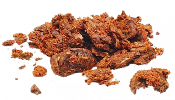
Like honey, propolis can be used both orally (by mouth) and as an external agent for topical applications.
Extracts (solutions), balsams, salves, creams with propolis can be taken inside and are used as well as external agents for inhalation, irrigation of the skin, mucous membranes and wounds, as well as for electrophoresis. Extract can be prepared with oil, water or alcohol. Native (whole) propolis is used less frequently than alcohol and oil extracts. If you are preparing your own home remedies with propolis make sure that the propolis is not heated higher than 100° C. The following solutions can be prepared from propolis:
- propolis water – used externally for irrigating mucous membranes, for inhalation and ingestion; it is distinguished for a high bactericidal activity. Should be stored in a refrigerator in a dark dish for no more than 3 months.
- water extract of propolis – used as an external remedy for rinsing, washing of wounds, inhalations or ingestion for diseases of the respiratory tract and gastrointestinal tract and for treatment of bronchial tuberculosis
- propolis milk – used for treatment of diseases of the stomach and intestines, as a general tonic and as an immune system stimulant. Keep refrigerated.
- alcohol solution (propolis tincture) – is the most pharmacologically active form of propolis. Alcohol tincture has analgesic, antiseptic, antiviral and antibacterial, deodorizing, antitoxic and antioxidant action. Its ingestion relieves regional vascular spasms, reduces blood clotting, stimulates metabolic processes and tissue regeneration and increases the body’s defenses. Depending on the nature and method of application, extracts of various concentrations are prepared – 5%, 10%, 20%, 40%, and 80%. Extracts of low concentration (5-10%) have lower pharmacological activity, extracts of 20-30% concentration – greater activity, but they irritate tissues more. It is better to use 15% extracts
External use of propolis tincture – treatment of oral mucous membrane and ENT (ears, nose, throat) diseases – oral diseases, mouth mucous lesions, middle ear inflammation, senile hearing loss, nasal mucosa, oropharynx, wounds in the oral cavity, tonsil disease, chronic diseases of the upper respiratory tract (when mixed with aloe juice, colanchoe and honey)
Internal use of propolis tincture – for colds, flu, acute and chronic bronchitis, pneumonia and for pulmonary tuberculosis, high blood pressure, and gastrointestinal diseases.
Inhalation of propolis tincture – for diseases of the respiratory tract.
- propolis butter – propolis butter 10-20% concentration can be ingested or used for topical applications. Inside use is indicated for diseases of the respiratory organs, pulmonary tuberculosis, and diseases of the gastrointestinal tract, including tuberculosis. It is used as a general tonic, which increases overall resistance and promotes faster healing. As an external agent, propolis butter is used in the treatment of chemical and thermal burns, difficult healing wounds and ulcers. The therapeutic effect of propolis butter in the treatment of burns and wounds is that it has an anesthetic property and is bactericidal with respect to many microbes (Gram-positive and Gram-negative groups). It enhances the regenerative processes of the wound, helps to improve blood and lymph circulation in the wound area, reducing the permeability of vessels of the wound surface. The dressing with propolis butter does not stick to the wound, does not damage granulation, especially after skin transplantation, when the graft was not firmly fixed to the wound;
- propolis ointments and suppositories – propolis is highly soluble in fats, which allows its use for the preparation of highly effective therapeutic forms, such as ointments and suppositories. Fat base and propolis concentrations are chosen according to indications. Ointment are used as an external remedy for the treatment of wounds, skin diseases (burns, frostbite, eczema, non-healing wounds, seborrheic eczema in children and adults, pyoderma, furuncle of the ear canal, inflammation of the middle ear, X-ray damage to the skin); for treatment of cervical erosion, anal fissures, postoperative wounds and rectal fistulas;
- suppositories with propolis – rectal suppositories with propolis are used for chronic proctosigmoiditis, anus fractures and chronic prostatitis, colpitis, metritis, parametrite, salpingitis, cervical erosion, hemorrhoids;
- alcohol and oil solution – alcohol propolis tincture of 30-40% is mixed with vegetable oil and used in the treatment of ear diseases in the form of drops;
- propolis and wax ointment – is used as an effective treatment for wounds;
- propolis and honey mix – The therapeutic effect of this mixture is higher than that of each component separately, which provides reason for its use in many diseases with good clinical effect. The mixture has a pronounced antiseptic, balsamic, deodorizing, wound healing, antipruritic, antitoxic and antioxidant action. It is used to relieve local vascular spasms, with arterial hypertension, in order to reduce blood coagulation and improve regenerative processes. Externally honey-propolis mixture is used to treat wounds, ulcers, burns, frostbite, as well as to treat conjunctivitis, sinusitis, rhinitis, gynecological diseases, rectal fissures, hemorrhoids. Irrigation of the mucous membranes is done with a 3-5% mixture diluted with boiled water in a 1:1 ratio. With conjunctivitis, the solution is placed in the eyes, with rhinitis, sinus – the nasal passages are washed by the solution through the nostril. With gynecological diseases – irrigation is performed. Dental diseases, angina, and pharyngitis are treated with undiluted mixture: 1/3 teaspoon for a long time held in the mouth until dissolved, the procedure is repeated several times a day. The mixture is used in the treatment of bronchitis, bronchial asthma, tuberculosis, migraine, hypertension, gastrointestinal diseases, acute and chronic colitis, diseases of the urinary tract, prostate, benign and malignant tumors;
For every product the concentration of propolis should be calculated with the maximum accuracy. This helps to control dosage of propolis used for treatment. Therapeutic and prophylactic dose of propolis depends on treated disease and method of application – internal or topical. The daily dose of propolis, according to most apitherapists, when taking orally, for an adult 3-10 g. For the course of treatment, 27-57 g is used, with acute diseases, less; with chronic diseases, more. The recommended dose should not be exceeded, as side effects are possible.
